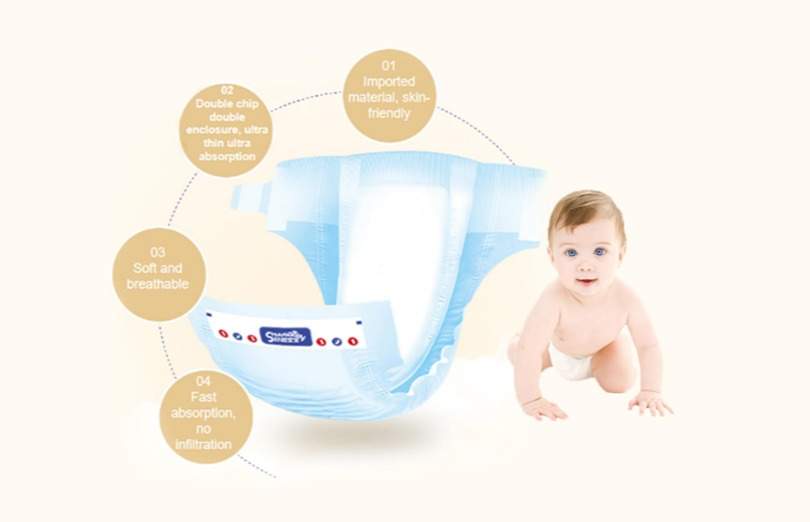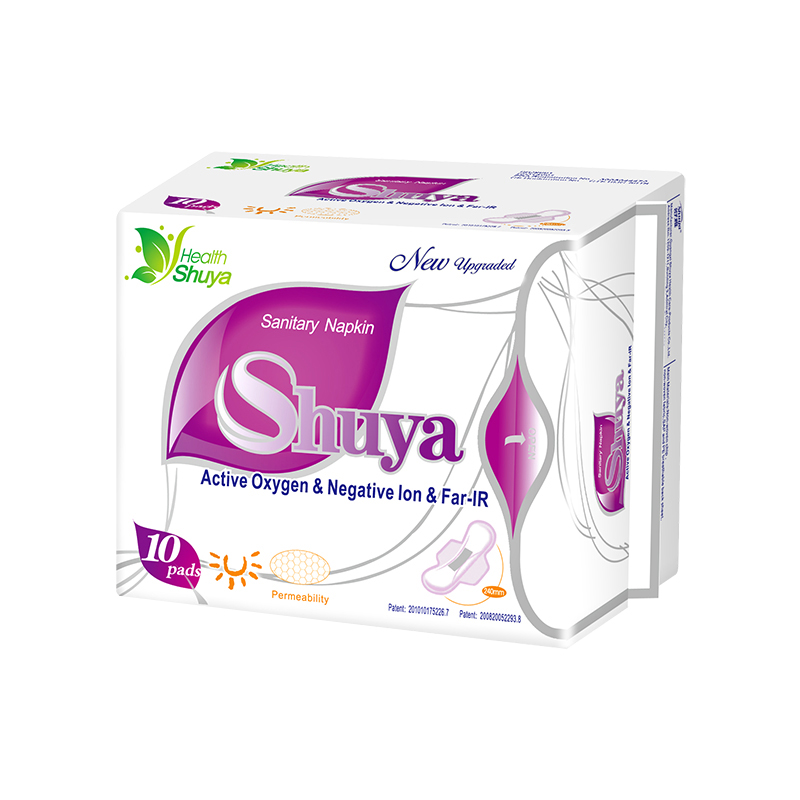Types of diapers come in disposable, cloth, hybrid, and other styles, among which disposable and cloth diapers are the two most popular ones. Disposables have superabsorbent polymers and fluff pulp. Cloth versions composed of cotton, microfiber, or bamboo need regular washing. Each has its advantages and suitability for a specific group. With so many types of diapers on the market, it’s important to choose the proper kind to boost usage efficiency while supporting the baby’s comfort expectations. This article will explore the two most common types of diapers, disposable and cloth, and their comparison.

baby diaper
Two Common Types of Diapers
1. Disposable Diapers
Due to their convenience for single-use, disposable diapers are popular for baby care. Disposable diapers are highly absorbent so that the baby’s skin can keep dry. These features make them a go-to option for parents. Superabsorbent polymers (SAPs), including sodium polyacrylate, are used in disposable diapers to absorb and retain liquid. The amount of liquid these polymers can hold is significantly high.
These types of diapers also use polypropylene nonwoven fabric on the top and back sheets. It is soft and breathable. Thus, babies may be less likely to suffer from skin irritation. Additionally, it helps minimize fluid leaks to prevent the baby’s clothing from being dirty.
The acquisition-distribution layer (ADL) is the essential component of disposable diapers. It consists of polyester or polypropylene, which swiftly distributes urine for better SAP performance. Consequently, disposable diapers maximize absorbency, skin dryness, and odor control.
Some disposable diapers might have a scent. Some babies can be sensitive to these fragrances. Sensitivity in babies can cause a rash. This rash may result from the contact of the diaper area or around the elastic edges of the skin. Choosing diapers that are labeled as unscented is important.

2. Cloth Diapers
On the other hand, cloth diapers are reusable and environmentally friendly. They use cotton, bamboo, or hemp as the main materials, which are known for their softness. Cloth diapers have three common types: all-in-one diapers, pre-fold diapers, and flat-folds.
To prevent leaks, these types of diapers may include a waterproof outer layer composed of TPU (thermoplastic polyurethane) or PUL (polyester urethane laminate). The absorbent core is made of multiple layers of material. In this way, liquids can be quickly absorbed and locked in diapers. Besides, a synthetic lining helps to create a barrier against wetness, keeping the baby’s skin dry. Cloth diapers are fastened around the baby by using Velcro, snaps, or pins. Velcro, snaps, or pins. These methods provide a secure fit that can be easily adjusted.
Cloth diapers have an advantage in sustainability and reusability, thereby reducing waste. Additionally, the ability to reuse them numerous times results in sustained economic advantages.
Types of Diapers Comparison
| Aspect | Disposable Diapers | Cloth Diapers |
| Cost | Higher initial cost, but no cost for laundry. | Lower long-term cost with laundry expenses included. |
| Convenience | Very convenient, no washing required | Less convenient with washing and drying required |
| Environmental Impact | High (not biodegradable, prompts landfill waste). | Lower (reusable, but energy and water are needed in laundering). |
| Comfort | Generally comfortable and less bulky with soft materials | Less comfortable for some babies and may cause skin irritation |
| Hygiene | Good absorption and less risk of bacteria | Requires more frequent changes to avoid leaks and rashes |
Choose the Right Type of Diaper for Specific Age
1. For Infants (0-12 months)
Infants’ physiological and developmental requirements must be considered when choosing the right type of diaper. Regular feedings cause frequent pee and feces, so newborns need absorbent diapers. SAPs are employed in these diapers to trap moisture and keep skin dry. The technique utilizes granules that absorb several times their weight in liquid to gel and prevent leaking.
Infant diapers need sturdy fastenings that won’t loosen during movement. Diapers are fastened with multi-tape to fit the baby’s small waist. These characteristics accommodate the infant’s growing motions.
Diaper rash might be caused by diaper dampness, so this is crucial to look for breathable materials. They can help reduce the risk of diaper rash and maintain the baby’s comfort. Note to look for diapers with materials that allow air to circulate. They can prevent moisture accumulation and keep the baby’s skin dry.
The diaper’s inside lining matters. It needs a soft, hypoallergenic layer that touches the skin. When wet, these materials must retain structural integrity to avoid clumping or sagging, which may cause worry or leakage. These features render the chosen types of diapers ideal for newborn safety and ease.
2. For Toddlers (12-36 months)
The correct types of diapers for toddlers must accommodate their growing movement. Elasticated sides are standard in toddler diapers to satisfy fast development and different body types. The diaper may be altered for a comfortable fit as the child develops. As a result, it eradicates leaks from a poorly fitted diaper. In addition, manufacturers may also use elastic waistbands and leg cuffs for leak prevention and mobility.
Besides that, easy change becomes a priority as toddlers acquire independence. At this time, pull-up diapers are popular because they look like underwear. These are simple for toddlers to put on and take off, which aids toilet training. Tear-away edges make these diapers easier to remove after mishaps. Many toddler diapers include multiple leak guards and high-capacity cores that prolong absorbency over hours while keeping the kid dry at night.
As the toddler investigates and interacts, the diaper must be comfortable throughout the extended activity. Thus, toddler diaper materials prioritize breathability and comfort. Such diapers include moisture-wicking fabrics and quick-drying cores to decrease skin discomfort during long usage. These diapers are cozy and reliable for daytime use and support toddlers’ developmental demands.
Please also read Reveal the Steps in Manufacturing Sanitary Pads.

Shuya: Your Trusted OEM Diaper Manufacturer
Established in 1985, Shuya has over 37 years of experience in offering hygiene products. As an experienced OEM manufacturer, Shuya creates types of diapers, including infant and adult versions, for market demands. Apart from diapers, we offer different hygiene products, such as sanitary napkins, panty liners, wet wipes, tissues, insoles, and face masks. What is more, our high productivity is up to a monthly average of 55 million pieces of sanitary pads and 155 million pieces of panty liners, which renders us unique in the business. Our ISO, CE, FDA, and SGS certifications reflect our fidelity to quality. Such reliability has attracted many of the world’s top 500 well-known brands from 60 countries. Along these lines, collaborating with us guarantees a steady supply of high-quality, customizable diaper solutions for your requirements and market.
Conclusion
With the comprehensive comparison of common types of diapers, cloth and disposable, it may not be hard to conclude that disposable diapers have an advantage over cloth diapers in many aspects. They are gaining more popularity among parents. For businesses that want to have OEM disposable diapers, don’t miss Shuya. We are one of the biggest manufacturers of personal care products in China. As we have been specialized in this industry for over 37 years, we clearly know how to offer the product that consumers like. For more information about OEM solutions for hygiene products, please visit our site.

